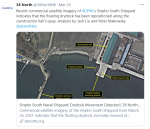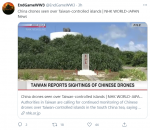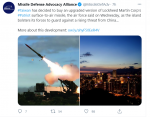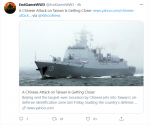You are using an out of date browser. It may not display this or other websites correctly.
You should upgrade or use an alternative browser.
You should upgrade or use an alternative browser.
ALERT The Winds of War Blow in Korea and The Far East
- Thread starter northern watch
- Start date
jward
passin' thru
Secretary Antony Blinken
@SecBlinken

United States government official
· 3h
The United States stands with our ally, the Philippines, in the face of the PRC's maritime militia amassing at WhitsunReef. We will always stand by our allies and stand up for the rules-based international order.
____________________________________
Duan Dang
@duandang
59m
The bulk of Chinese vessels anchoring at Whitsun Reef have left, according to Planet's satellite image on March 28.
View: https://twitter.com/duandang/status/1376352853267083264?s=20
@SecBlinken

United States government official
· 3h
The United States stands with our ally, the Philippines, in the face of the PRC's maritime militia amassing at WhitsunReef. We will always stand by our allies and stand up for the rules-based international order.
____________________________________
Duan Dang
@duandang
59m
The bulk of Chinese vessels anchoring at Whitsun Reef have left, according to Planet's satellite image on March 28.
View: https://twitter.com/duandang/status/1376352853267083264?s=20
jward
passin' thru

Indo-Pacific News - Watching the CCP-China Threat
@IndoPac_Info
#Australia threatens to take #China to #WTO and backs Boris Johnson's stance on #Uighur abuses Scott Morrison says #China’s 116.2% to 218.4% levies on Australia’s wine imports are ‘retaliation’
View: https://twitter.com/IndoPac_Info/status/1376529327471259649?s=20
northern watch
TB Fanatic
northern watch
TB Fanatic
Satellite Images Show N.Korea Preparing To Roll Out Secretive Ballistic Missile Submarine
BY TYLER DURDEN
ZERO HEDGE
MONDAY, MAR 29, 2021 - 06:00 PM
At a moment North Korea is blasting as 'hypocrisy' the UN Security Council condemnation of its latest short-range ballistic missile test from last week, which interestingly President Biden had merely shrugged off, there's an emerging consensus based on satellite imagery that Pyongyang is likely preparing deployment of a new submarine capable of firing nuclear ballistic missiles.
The submarine is undergoing launch preparations at North Korea's Sinpo shipyard, according to The Telegraph, which writes further, "New satellite images of the shipyard, on the east coast of the peninsula, show that a floating dry dock has been positioned alongside the launch quay for the vast construction hall where the submarine is being completed."
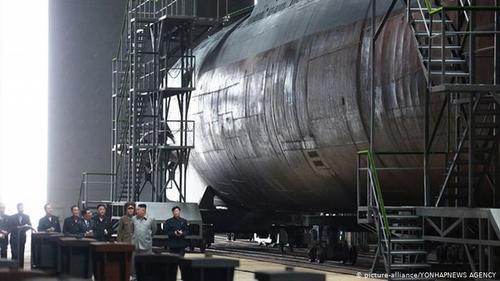
In the summer of 2019 North Korean state media featured pictures of Kim Jong-un inspecting the sub as it was being constructed.
Additionally the report said:
Earlier this year in January, state media touted the unveiling of a new type of submarine-launched ballistic missile which it called "the world's most powerful weapon" at a military parade overseen by Kim Jong-un.
Few details on the missile's capabilities have been given, and while subject of occasional reporting, the new submarine too has been a closely guarded secret. South Korean and US intelligence are said to be "thoroughly monitoring" the progress at the North's Sinpo shipyard.
The analysis site 38 North notes the following in relation to the new satellite imagery:
Analysts estimate that "The 2,720-tonne vessel that it is constructing is believed to be designed to carry three ballistic missiles and would theoretically be capable of sailing into the Pacific to threaten US military facilities in Hawaii or even the mainland of the continental US."
No doubt both Washington and regional allies, particularly Japan, would see a nuclear-capable sub deployment as a huge and alarming leap in the North's launch capabilities, given the complete mobility and lack of detection.
Satellite Images Show N.Korea Preparing To Roll Out Secretive Ballistic Missile Submarine | ZeroHedge
BY TYLER DURDEN
ZERO HEDGE
MONDAY, MAR 29, 2021 - 06:00 PM
At a moment North Korea is blasting as 'hypocrisy' the UN Security Council condemnation of its latest short-range ballistic missile test from last week, which interestingly President Biden had merely shrugged off, there's an emerging consensus based on satellite imagery that Pyongyang is likely preparing deployment of a new submarine capable of firing nuclear ballistic missiles.
The submarine is undergoing launch preparations at North Korea's Sinpo shipyard, according to The Telegraph, which writes further, "New satellite images of the shipyard, on the east coast of the peninsula, show that a floating dry dock has been positioned alongside the launch quay for the vast construction hall where the submarine is being completed."

In the summer of 2019 North Korean state media featured pictures of Kim Jong-un inspecting the sub as it was being constructed.
Additionally the report said:
Analysis of the images by experts from The Stimson Center think tank and posted on the 38 North web site suggest the new vessel "may be nearing completion or is ready to be rolled out and launched in the near future".
Earlier this year in January, state media touted the unveiling of a new type of submarine-launched ballistic missile which it called "the world's most powerful weapon" at a military parade overseen by Kim Jong-un.
Few details on the missile's capabilities have been given, and while subject of occasional reporting, the new submarine too has been a closely guarded secret. South Korean and US intelligence are said to be "thoroughly monitoring" the progress at the North's Sinpo shipyard.
The analysis site 38 North notes the following in relation to the new satellite imagery:
- Kim Jong Un visited the construction hall at Sinpho on July 23, 2019 to inspect a ROMEO-class submarine being modified to accommodate missile launch tubes.
- The parts yard adjacent to the construction halls, where large parts had been observed during the construction process, has been empty since last summer. This suggests major structural work has been completed.
Analysts estimate that "The 2,720-tonne vessel that it is constructing is believed to be designed to carry three ballistic missiles and would theoretically be capable of sailing into the Pacific to threaten US military facilities in Hawaii or even the mainland of the continental US."
No doubt both Washington and regional allies, particularly Japan, would see a nuclear-capable sub deployment as a huge and alarming leap in the North's launch capabilities, given the complete mobility and lack of detection.
Satellite Images Show N.Korea Preparing To Roll Out Secretive Ballistic Missile Submarine | ZeroHedge
northern watch
TB Fanatic
jward
passin' thru
Global: MilitaryInfo
@Global_Mil_Info
There are rumors coming out of Japan's Ministry of Defense, according to Zaobao, that Japan is planning to increase troops on Yonaguni Island which is only 111 km from Taiwan - a possible move that could increase a confrontation between Japan and China.
8:19 PM · Mar 29, 2021·Twitter Web App
@Global_Mil_Info
There are rumors coming out of Japan's Ministry of Defense, according to Zaobao, that Japan is planning to increase troops on Yonaguni Island which is only 111 km from Taiwan - a possible move that could increase a confrontation between Japan and China.
8:19 PM · Mar 29, 2021·Twitter Web App
jward
passin' thru
NK NEWS
@nknewsorg
4h
NEW: U.S. Secretary of State Antony Blinken condemned North Korea’s recent ballistic missile launch on Monday: -Called the test “a serious threat” -Stressed alliances -Said that U.S. and allies are ready to approach Pyongyang “from a position of strength”
View: https://twitter.com/nknewsorg/status/1376678399675146244?s=20
jward
passin' thru
Breaking911
@Breaking911
BREAKING: China approves radical overhaul of Hong Kong's political system - AFP
11:53 PM · Mar 29, 2021·Twitter for iPhone
Replying to
@AFP
#UPDATES Chinese leaders endorse a sweeping overhaul of Hong Kong's electoral system, slashing its number of directly elected seats and ensuring a majority of the city's lawmakers will be vetted and selected by reliably pro-Beijing committees
View: https://twitter.com/AFP/status/1376756869193068544?s=20
@Breaking911
BREAKING: China approves radical overhaul of Hong Kong's political system - AFP
11:53 PM · Mar 29, 2021·Twitter for iPhone
Replying to
@AFP
#UPDATES Chinese leaders endorse a sweeping overhaul of Hong Kong's electoral system, slashing its number of directly elected seats and ensuring a majority of the city's lawmakers will be vetted and selected by reliably pro-Beijing committees
View: https://twitter.com/AFP/status/1376756869193068544?s=20
jward
passin' thru
Indo-Pacific News - Watching the CCP-China Threat
@IndoPac_Info
3m
Two #Chinese ships enter #Japan's territorial waters off Senkaku Islands Beijing carries out yet another illegal intrusion - this time in Japan's territorial waters off the Senkaku Islands in the East China Sea
View: https://twitter.com/IndoPac_Info/status/1376767100534939648?s=20
@IndoPac_Info
3m
Two #Chinese ships enter #Japan's territorial waters off Senkaku Islands Beijing carries out yet another illegal intrusion - this time in Japan's territorial waters off the Senkaku Islands in the East China Sea
View: https://twitter.com/IndoPac_Info/status/1376767100534939648?s=20
Well here's a DOT......
Posted for fair use.....
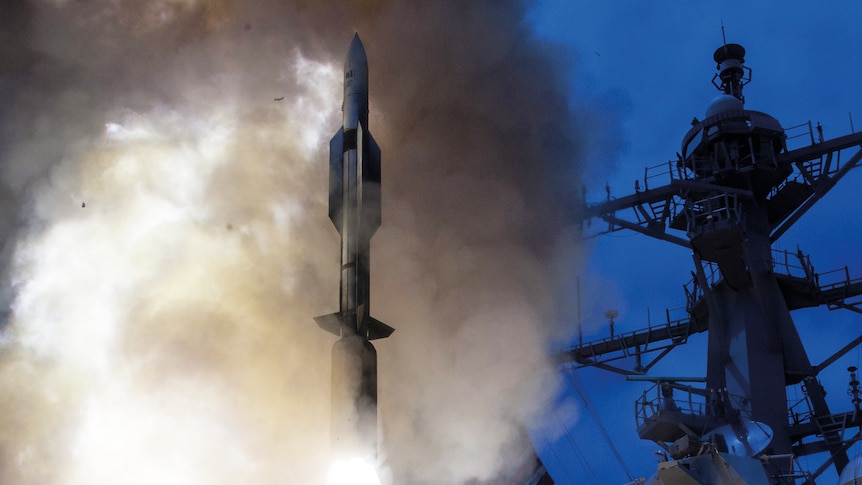
 www.abc.net.au
www.abc.net.au
Australia to produce its own guided missiles as part of billion-dollar defence manufacturing plan
Posted Yesterday at 3:28pm, updated Yesterday at 7:48pm

The government's plan will see missiles similar to this produced onshore.(
Supplied: Raytheon Australia
)
Share
Australia will move to produce its own guided missiles under a $1 billion plan to establish a new weapons facility with a global arms manufacturer.
Key points:
“As the COVID-19 pandemic has shown, having the ability for self-reliance, be it vaccine development or the defence of Australia, is vital to meeting our own requirements in a changing global environment," he said.
Potential partners include Raytheon Australia, Lockheed Martin Australia, Konsberg and BAE Systems Australia.
No location has been identified yet for the facility.
Defence recently announced it was partnering with the United States to develop and test an air-launched hypersonic cruise missile that can exceed the speed of sound by up to eight times.
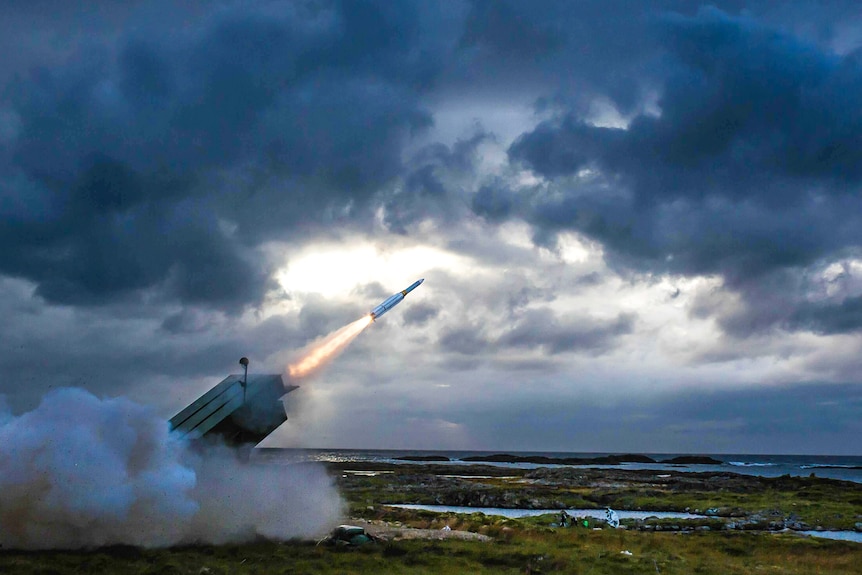
Funding for the new enterprise is part of the government's 10-year spend on Defence.(
Supplied: Raytheon Australia
)
Defence Minister Peter Dutton said Australia would work closely with the US on the new domestic guided missile project.
He said the project would "support both Australia's needs and the growing needs of our most important military partner".
The government is spending $270 billion over the next 10 years on defence projects.
Defence Industry Minister Melissa Price said domestically produced guided missiles would add to existing weapons technology in Australia, including the Nulka decoy missile, and explosives factories at Benalla and Mulwala.
"According to defence industry estimates this new national enterprise could be worth $40 billion in local production and export over the next 20 years," she said.
"Utilising sophisticated manufacturing processes, industry also says this could create well over 2,000 jobs in different locations across the nation."
The Prime Minister will provide further details on the announcement on this morning.
Posted Yesterday, updated Yesterday
Related Stories
Scott Morrison evokes World War II as Australia unveils larger, more lethal defence strategy

If Morrison's defence strategy sounds like war talk, that's because it is
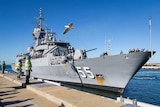
Under threat from China, the Pentagon wants to build a new missile defence base in the Pacific
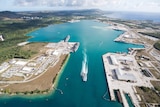
Posted for fair use.....
Australia to produce its own guided missiles as part of billion-dollar defence manufacturing plan
Australia will move to produce its own guided missiles under a $1 billion plan to establish a new weapons facility with a global arms manufacturer.
Australia to produce its own guided missiles as part of billion-dollar defence manufacturing plan
Posted Yesterday at 3:28pm, updated Yesterday at 7:48pm
The government's plan will see missiles similar to this produced onshore.(
Supplied: Raytheon Australia
)
Share
Australia will move to produce its own guided missiles under a $1 billion plan to establish a new weapons facility with a global arms manufacturer.
Key points:
- No location has been chosen yet for the new facility
- Scott Morrison says it will help make Australia more self-reliant in its defence capability
- It is part of the government's $270 billion spend on defence projects over the next 10 years
“As the COVID-19 pandemic has shown, having the ability for self-reliance, be it vaccine development or the defence of Australia, is vital to meeting our own requirements in a changing global environment," he said.
The Department of Defence will choose a "strategic industry partner" which will be contracted to operate the manufacturing facility."It’s an imperative we now proceed with the creation of a sovereign guided weapons capability as a priority."
Potential partners include Raytheon Australia, Lockheed Martin Australia, Konsberg and BAE Systems Australia.
No location has been identified yet for the facility.
Defence recently announced it was partnering with the United States to develop and test an air-launched hypersonic cruise missile that can exceed the speed of sound by up to eight times.
Funding for the new enterprise is part of the government's 10-year spend on Defence.(
Supplied: Raytheon Australia
)
Defence Minister Peter Dutton said Australia would work closely with the US on the new domestic guided missile project.
He said the project would "support both Australia's needs and the growing needs of our most important military partner".
The government is spending $270 billion over the next 10 years on defence projects.
Defence Industry Minister Melissa Price said domestically produced guided missiles would add to existing weapons technology in Australia, including the Nulka decoy missile, and explosives factories at Benalla and Mulwala.
"According to defence industry estimates this new national enterprise could be worth $40 billion in local production and export over the next 20 years," she said.
"Utilising sophisticated manufacturing processes, industry also says this could create well over 2,000 jobs in different locations across the nation."
The Prime Minister will provide further details on the announcement on this morning.
Posted Yesterday, updated Yesterday
Related Stories
Scott Morrison evokes World War II as Australia unveils larger, more lethal defence strategy
If Morrison's defence strategy sounds like war talk, that's because it is
Under threat from China, the Pentagon wants to build a new missile defence base in the Pacific
Another DOT.....
Posted for fair use.....
:quality(70)/cloudfront-us-east-1.images.arcpublishing.com/archetype/CA7IWVN2WNERLE4UJOH2JK3RIM.jpg)
 www.defensenews.com
www.defensenews.com
Japan, Indonesia sign arms transfer pact amid China concerns
By: Mari Yamaguchi, The Associated Press 11 hours ago
/cloudfront-us-east-1.images.arcpublishing.com/mco/CA7IWVN2WNERLE4UJOH2JK3RIM.jpg) Indonesian Foreign Minister Retno Marsudi, from left, Defense Minister Prabowo Subianto, Japanese Foreign Minister Toshimitsu Motegi and Defense Minister Kishi Nobuo pose for a photo during a signing ceremony for their foreign and defense ministers' meetings in Tokyo on Tuesday, March 30, 2021. (David Mareuil/Pool Photo via AP)
Indonesian Foreign Minister Retno Marsudi, from left, Defense Minister Prabowo Subianto, Japanese Foreign Minister Toshimitsu Motegi and Defense Minister Kishi Nobuo pose for a photo during a signing ceremony for their foreign and defense ministers' meetings in Tokyo on Tuesday, March 30, 2021. (David Mareuil/Pool Photo via AP)
TOKYO — Japan and Indonesia signed a pact on Tuesday allowing the transfer of Japanese defense equipment and technology to Jakarta as the two countries strengthen their military ties in the face of China’s increasingly assertive activity in the region.
The agreement came during “two plus two” security talks among the foreign and defense ministers of the two countries, which share concerns about China’s growing influence and territorial claims in the East and South China seas.
“It has become difficult to take for granted the premises that have supported the peace and prosperity of the international community,” Japanese Foreign Minister Toshimitsu Motegi said in opening remarks at the talks.
Motegi and Defense Minister Nobuo Kishi and their Indonesian counterparts, Retno Marsudi and Prabowo Subianto, also agreed to actively participate in multinational military exercises and jointly develop remote islands in the South China Sea.
The ministers “shared grave concern over the continuation and escalation of an attempt to change the status quo by force” and agreed on the importance of observing a rules-based maritime order and respect for international maritime laws, Japan’s Foreign Ministry said in a statement.
“Together we will maintain and strengthen a free and open maritime order,” Kishi said at a joint news conference after the talks. He said the two countries will speed up a decision on the details of Japanese exports of defense equipment to Indonesia.
The security talks come two weeks after Japan and its key ally, the United States, held security talks in which they condemned Chinese “coercion and aggression” toward its neighbors in Asia.
The Japanese and Indonesian ministers also shared “serious concern” over the killings of pro-democracy protestors by the Myanmar military, agreeing to closely cooperate in efforts to improve the situation in that country.
Posted for fair use.....
:quality(70)/cloudfront-us-east-1.images.arcpublishing.com/archetype/CA7IWVN2WNERLE4UJOH2JK3RIM.jpg)
Japan, Indonesia sign arms transfer pact amid China concerns
Japan and Indonesia signed a pact on Tuesday allowing the transfer of Japanese defense equipment and technology to Jakarta as the two countries strengthen their military ties in the face of China's increasingly assertive activity in the region.
Japan, Indonesia sign arms transfer pact amid China concerns
By: Mari Yamaguchi, The Associated Press 11 hours ago
/cloudfront-us-east-1.images.arcpublishing.com/mco/CA7IWVN2WNERLE4UJOH2JK3RIM.jpg)
TOKYO — Japan and Indonesia signed a pact on Tuesday allowing the transfer of Japanese defense equipment and technology to Jakarta as the two countries strengthen their military ties in the face of China’s increasingly assertive activity in the region.
The agreement came during “two plus two” security talks among the foreign and defense ministers of the two countries, which share concerns about China’s growing influence and territorial claims in the East and South China seas.
“It has become difficult to take for granted the premises that have supported the peace and prosperity of the international community,” Japanese Foreign Minister Toshimitsu Motegi said in opening remarks at the talks.
Motegi and Defense Minister Nobuo Kishi and their Indonesian counterparts, Retno Marsudi and Prabowo Subianto, also agreed to actively participate in multinational military exercises and jointly develop remote islands in the South China Sea.
The ministers “shared grave concern over the continuation and escalation of an attempt to change the status quo by force” and agreed on the importance of observing a rules-based maritime order and respect for international maritime laws, Japan’s Foreign Ministry said in a statement.
“Together we will maintain and strengthen a free and open maritime order,” Kishi said at a joint news conference after the talks. He said the two countries will speed up a decision on the details of Japanese exports of defense equipment to Indonesia.
The security talks come two weeks after Japan and its key ally, the United States, held security talks in which they condemned Chinese “coercion and aggression” toward its neighbors in Asia.
The Japanese and Indonesian ministers also shared “serious concern” over the killings of pro-democracy protestors by the Myanmar military, agreeing to closely cooperate in efforts to improve the situation in that country.
Posted for fair use.....
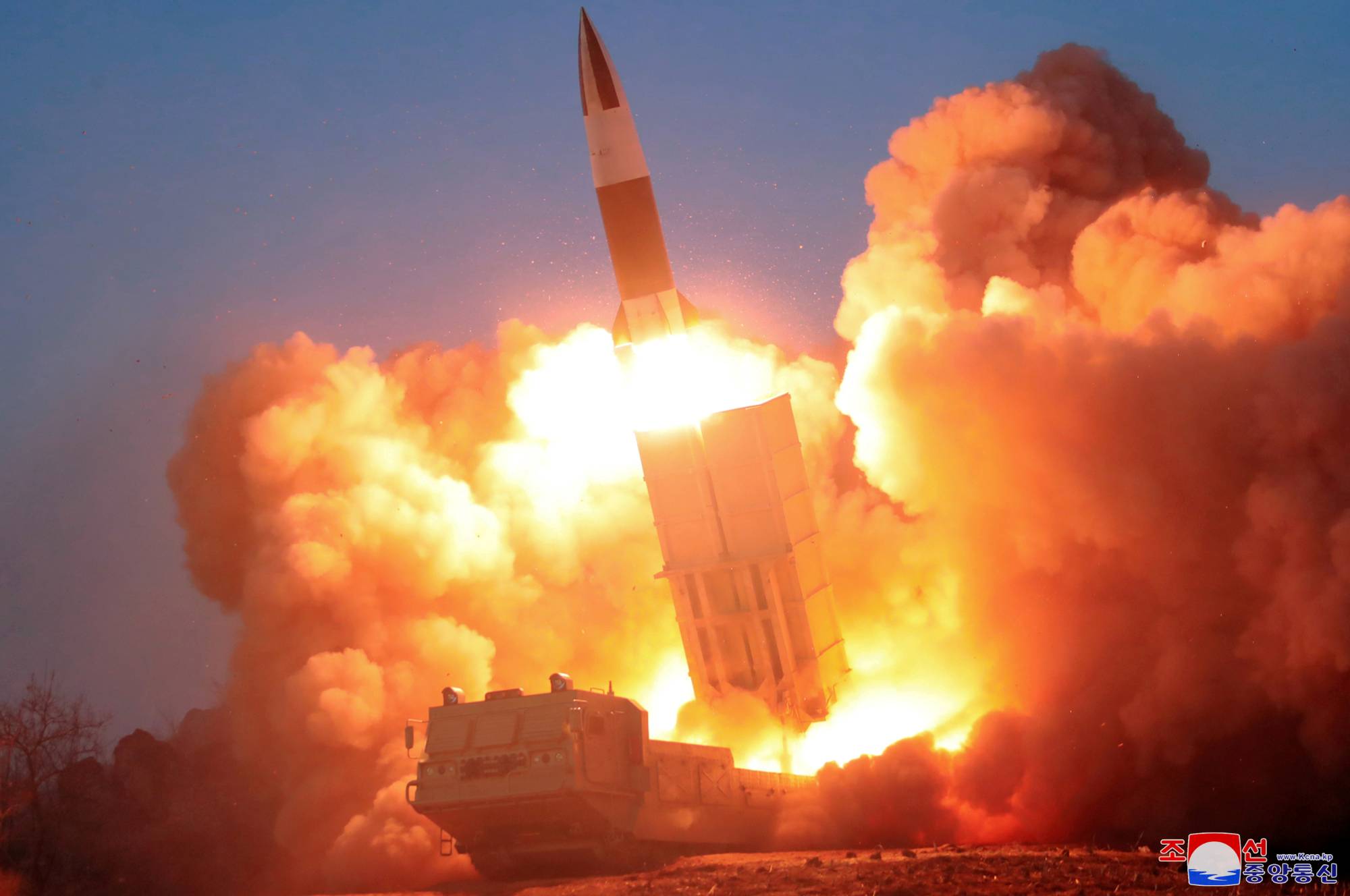
 www.japantimes.co.jp
www.japantimes.co.jp
Asia Pacific | ANALYSIS
Inter-Korean missile race may leave North Korea with tactical nuclear weapons
SEOUL – North Korea has surged ahead in recent years in an inter-Korean arms race that has led to a proliferation of short-range missiles on the peninsula and left Pyongyang closer than ever to deploying tactical nuclear weapons.
North Korea’s yearslong quest to develop precision missiles capable of evading detection and striking targets in South Korea has accelerated in the wake of the country’s 2018 self-imposed moratorium on testing its larger intercontinental ballistic missiles (ICBMs).
Meanwhile, a 2017 agreement between Washington and Seoul lifted bilateral limits on South Korean missile payloads, leading to the development of at least one heavier weapon that could play a key role in strategies aimed at preempting North Korean attacks or “decapitating” its leadership.
The new missiles tested by North Korea last week appear aimed at matching or surpassing South Korea’s quietly expanding arsenal, and are the first such tests since leader Kim Jong Un declared in January that the country could miniaturize nuclear warheads to fit on tactical weapons, underscoring the high stakes for the Biden administration as it mulls options for reducing tensions.
South Korean officials see bigger and better short-range ballistic missiles (SRBMs) as a way to reduce their dependence on the United States, which stations around 28,500 troops in South Korea.
 North Korean leader Kim Jong Un attends an event in Pyongyang on Saturday. | KCNA / VIA REUTERS
North Korean leader Kim Jong Un attends an event in Pyongyang on Saturday. | KCNA / VIA REUTERS
In a speech last year, South Korean Defense Minister Jeong Kyeong-doo boasted that the country had developed a missile with “sufficient range and the world’s largest warhead weight to protect peace on the Korean Peninsula,” referring to the new Hyunmoo-4’s 800-kilometer range and 2-ton payload.
It was likely no coincidence, analysts noted, that North Korea said its newest SRBM could carry a 2.5-ton warhead.
In a statement on Tuesday, Kim Yo Jong, the leader’s sister and a powerful politician in North Korea, cited Jeong’s speech in defending the North’s right to develop its own missiles.
“As Seoul has developed new capabilities of this type, Pyongyang has been close behind,” said Joshua Pollack, a researcher at the James Martin Center for Nonproliferation Studies (CNS) who co-wrote a report last year warning that advances in conventional, precision strike missiles in both Koreas have helped create a new pathway for a crisis to escalate into war.
North Korea says its missiles are for self defense, and has accused South Korea and the United States of threatening its safety with joint military drills, arms purchases and other hostile policies.
At January’s ruling party congress, Kim announced that North Korea had accumulated technology to “miniaturize, lighten and standardize” nuclear weapons.
The South’s spy agency concluded the latest missiles could carry nuclear warheads, though it was unclear whether they had ever been installed, a lawmaker briefed by intelligence officials said on Monday.
 U.S. Army soldiers and South Korean Marines take part in a joint military exercise in Pohang, South Korea, on Thursday. | YONHAP / VIA REUTERS
U.S. Army soldiers and South Korean Marines take part in a joint military exercise in Pohang, South Korea, on Thursday. | YONHAP / VIA REUTERS
“Even short-range North Korean ballistic missiles should be considered nuclear-capable, based on North Korea’s own words,” said Markus Garlauskas, a senior fellow with the Atlantic Council and former U.S. national intelligence officer for North Korea.
Once the technology is mastered, nuclear warheads can be lighter than conventional ones, said Markus Schiller, a missile expert based in Europe.
“A missile does not care the least if it carries a nuke, a load of TNT, or a piano — only the weight is important,” he said.
North Korea’s latest missiles have also demonstrated a capability for flying low and “pulling up” shortly before reaching their target, making them harder to detect and intercept, said Joseph Dempsey, a defense researcher at the International Institute for Strategic Studies.
“If fielded, these new type of SRBMs would allow North Korea to strike specific targets within South Korea with a much higher degree of accuracy (than older variants),” he said.
On Friday, 38 North, a U.S.-based think tank, reported that satellite imagery showed activity at a shipyard suggesting the North’s new ballistic missile submarine, under construction for several years, may be nearing completion.
In a speech on Friday where he discussed North Korea’s tests, South Korean President Moon Jae-in described his country’s missile capability as “world class.”
After last year’s test of the Hyunmoo-4, South Korea announced it would also mass produce another type of ground-based missile designed to destroy underground artillery bases.
“These most recent (North Korean) tests do appear to be communicating to the South Koreans that they have capability on par or superseding that of the Hyunmoo-4,” said Melissa Hanham, deputy director of the Open Nuclear Network.
As soon as this year, Seoul may conduct an underwater test of its first submarine-launched ballistic missile (SLBM), based on the 500 kilometer-range Hyunmoo-2B, armed with a conventional warhead, and potentially carried by its new 3,000-ton KSS III submarines, South Korean media reported.
South Korea’s Defense Ministry declined to confirm the status of specific weapons citing security concerns but said “our military has built the capability to counter North Korea’s short range missiles by modernizing our forces, and we plan to develop it even further.”
Such missiles could bolster two key South Korean strategies: “Overwhelming Response,” which aims to detect planned attacks by North Korea and preemptively destroy its nuclear facilities, missiles, and long-range artillery; and “Strategic Target Strike,” a counterattack that includes eliminating North Korean leadership.
“Seoul seems committed to very large conventional warheads to target hardened sites,” said Jeffrey Lewis, a missile researcher at CNS. “There is also simple envy — if North Korea has such a capability, it is normal for South Korea to follow suit.”

Inter-Korean missile race may leave North Korea with tactical nuclear weapons
North Korea's yearslong quest to develop precision missiles capable of evading detection and striking targets in South Korea has accelerated.
Asia Pacific | ANALYSIS
Inter-Korean missile race may leave North Korea with tactical nuclear weapons
-
 A suspected missile is fired in a photo released by North Korea's state news agency in March 2020. | KCNA / VIA REUTERS
A suspected missile is fired in a photo released by North Korea's state news agency in March 2020. | KCNA / VIA REUTERS
- by Josh Smith
Reuters
- Mar 31, 2021
SEOUL – North Korea has surged ahead in recent years in an inter-Korean arms race that has led to a proliferation of short-range missiles on the peninsula and left Pyongyang closer than ever to deploying tactical nuclear weapons.
North Korea’s yearslong quest to develop precision missiles capable of evading detection and striking targets in South Korea has accelerated in the wake of the country’s 2018 self-imposed moratorium on testing its larger intercontinental ballistic missiles (ICBMs).
Meanwhile, a 2017 agreement between Washington and Seoul lifted bilateral limits on South Korean missile payloads, leading to the development of at least one heavier weapon that could play a key role in strategies aimed at preempting North Korean attacks or “decapitating” its leadership.
The new missiles tested by North Korea last week appear aimed at matching or surpassing South Korea’s quietly expanding arsenal, and are the first such tests since leader Kim Jong Un declared in January that the country could miniaturize nuclear warheads to fit on tactical weapons, underscoring the high stakes for the Biden administration as it mulls options for reducing tensions.
South Korean officials see bigger and better short-range ballistic missiles (SRBMs) as a way to reduce their dependence on the United States, which stations around 28,500 troops in South Korea.
 North Korean leader Kim Jong Un attends an event in Pyongyang on Saturday. | KCNA / VIA REUTERS
North Korean leader Kim Jong Un attends an event in Pyongyang on Saturday. | KCNA / VIA REUTERSIn a speech last year, South Korean Defense Minister Jeong Kyeong-doo boasted that the country had developed a missile with “sufficient range and the world’s largest warhead weight to protect peace on the Korean Peninsula,” referring to the new Hyunmoo-4’s 800-kilometer range and 2-ton payload.
It was likely no coincidence, analysts noted, that North Korea said its newest SRBM could carry a 2.5-ton warhead.
In a statement on Tuesday, Kim Yo Jong, the leader’s sister and a powerful politician in North Korea, cited Jeong’s speech in defending the North’s right to develop its own missiles.
“As Seoul has developed new capabilities of this type, Pyongyang has been close behind,” said Joshua Pollack, a researcher at the James Martin Center for Nonproliferation Studies (CNS) who co-wrote a report last year warning that advances in conventional, precision strike missiles in both Koreas have helped create a new pathway for a crisis to escalate into war.
North Korea says its missiles are for self defense, and has accused South Korea and the United States of threatening its safety with joint military drills, arms purchases and other hostile policies.
At January’s ruling party congress, Kim announced that North Korea had accumulated technology to “miniaturize, lighten and standardize” nuclear weapons.
The South’s spy agency concluded the latest missiles could carry nuclear warheads, though it was unclear whether they had ever been installed, a lawmaker briefed by intelligence officials said on Monday.
 U.S. Army soldiers and South Korean Marines take part in a joint military exercise in Pohang, South Korea, on Thursday. | YONHAP / VIA REUTERS
U.S. Army soldiers and South Korean Marines take part in a joint military exercise in Pohang, South Korea, on Thursday. | YONHAP / VIA REUTERS“Even short-range North Korean ballistic missiles should be considered nuclear-capable, based on North Korea’s own words,” said Markus Garlauskas, a senior fellow with the Atlantic Council and former U.S. national intelligence officer for North Korea.
Once the technology is mastered, nuclear warheads can be lighter than conventional ones, said Markus Schiller, a missile expert based in Europe.
“A missile does not care the least if it carries a nuke, a load of TNT, or a piano — only the weight is important,” he said.
North Korea’s latest missiles have also demonstrated a capability for flying low and “pulling up” shortly before reaching their target, making them harder to detect and intercept, said Joseph Dempsey, a defense researcher at the International Institute for Strategic Studies.
“If fielded, these new type of SRBMs would allow North Korea to strike specific targets within South Korea with a much higher degree of accuracy (than older variants),” he said.
On Friday, 38 North, a U.S.-based think tank, reported that satellite imagery showed activity at a shipyard suggesting the North’s new ballistic missile submarine, under construction for several years, may be nearing completion.
In a speech on Friday where he discussed North Korea’s tests, South Korean President Moon Jae-in described his country’s missile capability as “world class.”
After last year’s test of the Hyunmoo-4, South Korea announced it would also mass produce another type of ground-based missile designed to destroy underground artillery bases.
“These most recent (North Korean) tests do appear to be communicating to the South Koreans that they have capability on par or superseding that of the Hyunmoo-4,” said Melissa Hanham, deputy director of the Open Nuclear Network.
As soon as this year, Seoul may conduct an underwater test of its first submarine-launched ballistic missile (SLBM), based on the 500 kilometer-range Hyunmoo-2B, armed with a conventional warhead, and potentially carried by its new 3,000-ton KSS III submarines, South Korean media reported.
South Korea’s Defense Ministry declined to confirm the status of specific weapons citing security concerns but said “our military has built the capability to counter North Korea’s short range missiles by modernizing our forces, and we plan to develop it even further.”
Such missiles could bolster two key South Korean strategies: “Overwhelming Response,” which aims to detect planned attacks by North Korea and preemptively destroy its nuclear facilities, missiles, and long-range artillery; and “Strategic Target Strike,” a counterattack that includes eliminating North Korean leadership.
“Seoul seems committed to very large conventional warheads to target hardened sites,” said Jeffrey Lewis, a missile researcher at CNS. “There is also simple envy — if North Korea has such a capability, it is normal for South Korea to follow suit.”
Posted for fair use.....
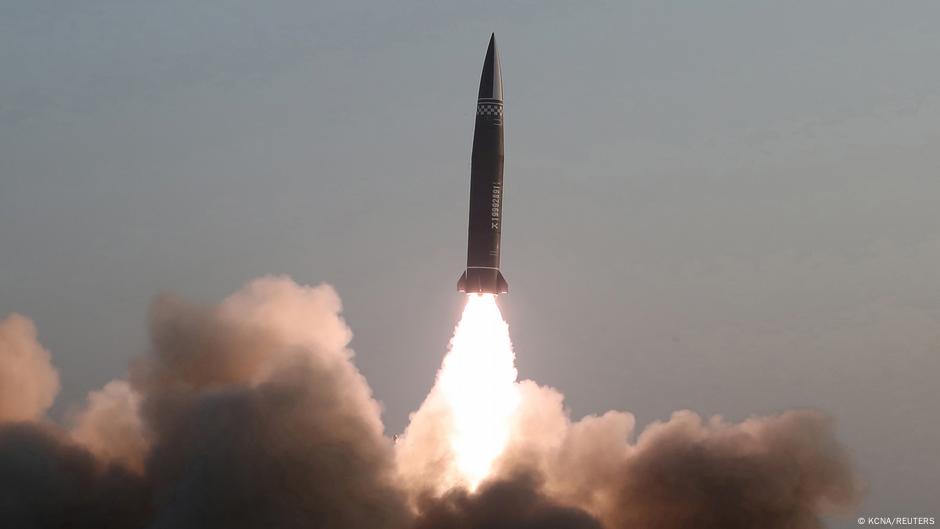
 www.dw.com
www.dw.com
Asia
Why is North Korea testing weapons again?
After a long pause, North Korea is again testing the resolve of the international community by launching ballistic missiles. But what is Pyongyang's endgame?
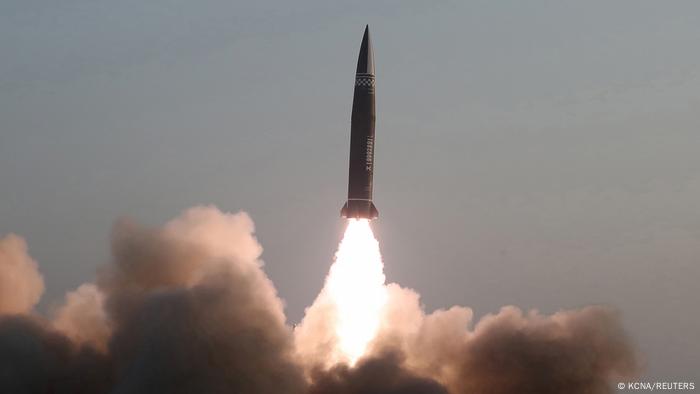
A ballistic missile launched on March 25 in North Korea
North Korea is often referred to as the "hermit kingdom," because it cuts off communication with the outside world, and a highly censored media inhibits reporting on the country and its government.
But when it comes to developing nuclear weapons and missiles, Pyongyang has actually been quite clear about its intentions.
"North Korea laid out their future nuclear development road map. They've been saying this for a while, showing it in their parades and discussing it in the last party congress," senior fellow Go Myong-hyun of Seoul's Asan Institute for Policy Studies told DW.
In January, North Korea held the 8th Congress of the Workers Party of Korea, with thousands of delegates from across the country gathering in Pyongyang.
The event culminated with a parade featuring displays of advanced missiles and military technology. It also included a warning to the US and South Korea against large-scale joint military drills.
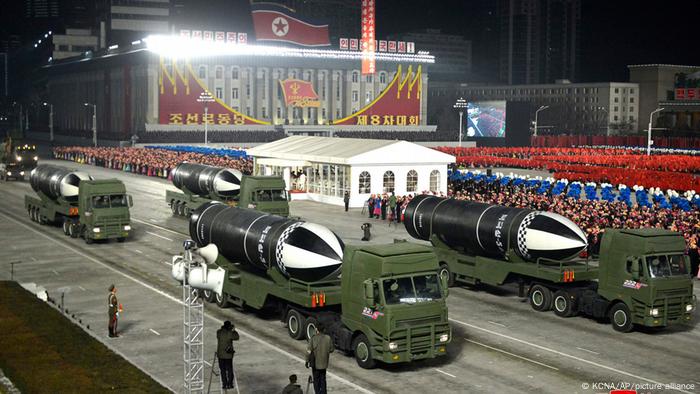
A military parade in Pyongyang showcases missiles
When North Korean leader Kim Jong Un met former US President Donald Trump in Singapore in 2018, they made a deal suspending large-scale joint US-South Korea military drills in exchange for Kim agreeing to a moratorium on long-range missile or nuclear tests.
The US side has refrained from holding the large-scale drills. But when South Korea and the US conducted 10 days of command post simulated war game drills earlier this March, it drew Pyongyang's ire.
"War games and hostility can never go with dialogue and cooperation," said Kim Jong Un's sister, Kim Yo Jong, warning that the US "better refrain from causing a stink" if it "wants to sleep in peace for the coming four years."
North Korea tests Joe Biden
On Sunday, March 21, North Korea fired off two cruise missiles. Four days later it fired two short-range ballistic missiles, a type which violates UN Security Council sanctions.
Many Korea observers have considered the recent tests as being a message to the new administration of US President Joe Biden. However, Biden downplayed the cruise missile tests, calling them "nothing new."
"When the US downplayed the cruise missiles, North Korea realized they had to add to the dosage. Pyongyang's modus operandi is to start small, build up the momentum of their provocations … and give just the right amount of shock," said Go.
Watch video 05:14
N. Korea missile launch also sends internal message: Jeongmin Kim
The timing of the tests came after US Secretary of State Antony Blinken and Defense Secretary Lloyd Austin were visiting US allies South Korea and Japan. On the agenda in Seoul was discussion of Washington's much anticipated review of US-North Korea policy.
The same day as the ballistic missile tests, President Biden gave his first official press conference as US president.
When he was asked about his "red line" on North Korea, Biden responded: "if they choose to escalate, we will respond accordingly. But I'm also prepared for some form of diplomacy, but it has to be conditioned upon the end result of denuclearization."
Christian Taaks, head of the Korea office at Germany's Friedrich Naumann Foundation, an NGO active inside North Korea for 18 years, told DW he views the tests as clear signaling to the Biden administration.
Taaks said North Korea timed the missile tests to coincide with Biden's press conference. Pyongyang had not responded to earlier overtures for dialogue issued by the Biden administration.
What are North Korea's capabilities?
Pyongyang also uses missile tests to test the capabilities of their weaponry, which officials have said involves a "new type" of missile.
"We have seen all of this new weapons technology in recent parades, but very few tests in the last year," said Taaks. "I think they just felt they had to complete a few tests before they go back to the negotiating table," he added.
North Korea has tested these types of missiles before, although it had been 11 months since its last short-range ballistic missile test.
But things get more complicated when coupled with intelligence suggesting that Pyongyang is also increasing its nuclear warhead stockpile.
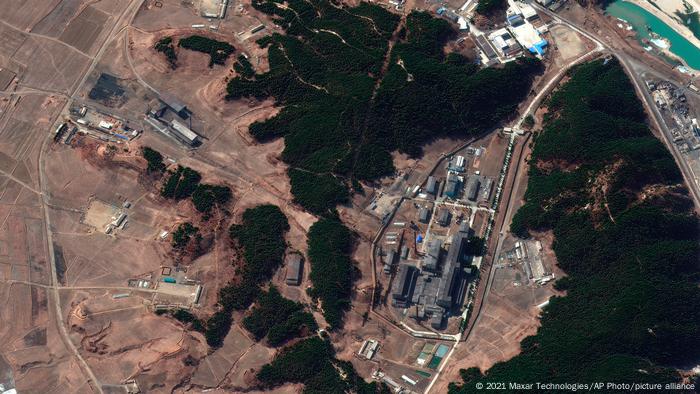
Recent satellite images of the Yongbyon nuclear complex show activity
Asan's Go said that raising the level of deterrence to counter hundreds of potential North Korean nuclear warheads would require building more missile defense systems, bringing in more tactical nuclear weapons or even strategic assets to the Korean Peninsula.
"You're not just deterring North Korea, you're also effecting China's deterrence posture, which is going to make them mad, as we've seen with the THAAD missile deployment," Go said.
THAAD, or Terminal High Altitude Area Defense, were anti-ballistic missile batteries deployed to South Korea in 2017. Their installation raised concerns in South Korea of potentially sparking an arms control race in East Asia.
What comes next for the US and North Korea?
"What is needed is time for the US and North Korea to find their way back to the negotiating table … Washington needs to listen to North Korea, and North Korea will need to make clear its intention toward denuclearization," Hong Suk-hoon, a research fellow at the Korea Institute for National Unification, told DW
However, given the recent rhetoric out of North Korea, and its continued development of nuclear weapons systems and warheads, many North Korea watchers believe Pyongyang will never give up their nuclear weapons, at least not enough to satisfy the US.
As with past US administrations, there is always optimism that negotiations with a new president can produce compromise. Pyongyang has much to gain with a deal that could suspend of eliminate crippling international sanctions.
Go believes the most likely possible outcome would be an intermediate arms reduction deal.
"North Korea's denuclearization is not going to happen anytime soon, at least not in a single US presidency. It's going to take a much longer time than that," he said.
Watch video 01:57
Blinken urges China to persuade N. Korea to denuclearize

Why is North Korea testing weapons again? – DW – 03/30/2021
After a long pause, North Korea is again testing the resolve of the international community by launching ballistic missiles. But what is Pyongyang's endgame?
Asia
Why is North Korea testing weapons again?
After a long pause, North Korea is again testing the resolve of the international community by launching ballistic missiles. But what is Pyongyang's endgame?

A ballistic missile launched on March 25 in North Korea
North Korea is often referred to as the "hermit kingdom," because it cuts off communication with the outside world, and a highly censored media inhibits reporting on the country and its government.
But when it comes to developing nuclear weapons and missiles, Pyongyang has actually been quite clear about its intentions.
"North Korea laid out their future nuclear development road map. They've been saying this for a while, showing it in their parades and discussing it in the last party congress," senior fellow Go Myong-hyun of Seoul's Asan Institute for Policy Studies told DW.
In January, North Korea held the 8th Congress of the Workers Party of Korea, with thousands of delegates from across the country gathering in Pyongyang.
The event culminated with a parade featuring displays of advanced missiles and military technology. It also included a warning to the US and South Korea against large-scale joint military drills.

A military parade in Pyongyang showcases missiles
When North Korean leader Kim Jong Un met former US President Donald Trump in Singapore in 2018, they made a deal suspending large-scale joint US-South Korea military drills in exchange for Kim agreeing to a moratorium on long-range missile or nuclear tests.
The US side has refrained from holding the large-scale drills. But when South Korea and the US conducted 10 days of command post simulated war game drills earlier this March, it drew Pyongyang's ire.
"War games and hostility can never go with dialogue and cooperation," said Kim Jong Un's sister, Kim Yo Jong, warning that the US "better refrain from causing a stink" if it "wants to sleep in peace for the coming four years."
North Korea tests Joe Biden
On Sunday, March 21, North Korea fired off two cruise missiles. Four days later it fired two short-range ballistic missiles, a type which violates UN Security Council sanctions.
Many Korea observers have considered the recent tests as being a message to the new administration of US President Joe Biden. However, Biden downplayed the cruise missile tests, calling them "nothing new."
"When the US downplayed the cruise missiles, North Korea realized they had to add to the dosage. Pyongyang's modus operandi is to start small, build up the momentum of their provocations … and give just the right amount of shock," said Go.
Watch video 05:14
N. Korea missile launch also sends internal message: Jeongmin Kim
The timing of the tests came after US Secretary of State Antony Blinken and Defense Secretary Lloyd Austin were visiting US allies South Korea and Japan. On the agenda in Seoul was discussion of Washington's much anticipated review of US-North Korea policy.
The same day as the ballistic missile tests, President Biden gave his first official press conference as US president.
When he was asked about his "red line" on North Korea, Biden responded: "if they choose to escalate, we will respond accordingly. But I'm also prepared for some form of diplomacy, but it has to be conditioned upon the end result of denuclearization."
Christian Taaks, head of the Korea office at Germany's Friedrich Naumann Foundation, an NGO active inside North Korea for 18 years, told DW he views the tests as clear signaling to the Biden administration.
Taaks said North Korea timed the missile tests to coincide with Biden's press conference. Pyongyang had not responded to earlier overtures for dialogue issued by the Biden administration.
What are North Korea's capabilities?
Pyongyang also uses missile tests to test the capabilities of their weaponry, which officials have said involves a "new type" of missile.
"We have seen all of this new weapons technology in recent parades, but very few tests in the last year," said Taaks. "I think they just felt they had to complete a few tests before they go back to the negotiating table," he added.
North Korea has tested these types of missiles before, although it had been 11 months since its last short-range ballistic missile test.
But things get more complicated when coupled with intelligence suggesting that Pyongyang is also increasing its nuclear warhead stockpile.

Recent satellite images of the Yongbyon nuclear complex show activity
Asan's Go said that raising the level of deterrence to counter hundreds of potential North Korean nuclear warheads would require building more missile defense systems, bringing in more tactical nuclear weapons or even strategic assets to the Korean Peninsula.
"You're not just deterring North Korea, you're also effecting China's deterrence posture, which is going to make them mad, as we've seen with the THAAD missile deployment," Go said.
THAAD, or Terminal High Altitude Area Defense, were anti-ballistic missile batteries deployed to South Korea in 2017. Their installation raised concerns in South Korea of potentially sparking an arms control race in East Asia.
What comes next for the US and North Korea?
"What is needed is time for the US and North Korea to find their way back to the negotiating table … Washington needs to listen to North Korea, and North Korea will need to make clear its intention toward denuclearization," Hong Suk-hoon, a research fellow at the Korea Institute for National Unification, told DW
However, given the recent rhetoric out of North Korea, and its continued development of nuclear weapons systems and warheads, many North Korea watchers believe Pyongyang will never give up their nuclear weapons, at least not enough to satisfy the US.
As with past US administrations, there is always optimism that negotiations with a new president can produce compromise. Pyongyang has much to gain with a deal that could suspend of eliminate crippling international sanctions.
Go believes the most likely possible outcome would be an intermediate arms reduction deal.
"North Korea's denuclearization is not going to happen anytime soon, at least not in a single US presidency. It's going to take a much longer time than that," he said.
Watch video 01:57
Blinken urges China to persuade N. Korea to denuclearize
- Date 30.03.2021
- Author Frank Smith (Seoul)
northern watch
TB Fanatic
Australia to build guided missiles to boost defense capacity
Australia says it will begin building its own guided missiles in close collaboration with the U.S. as it seeks to boost its defense capabilities
By NICK PERRY Associated Press
30 March 2021, 21:15
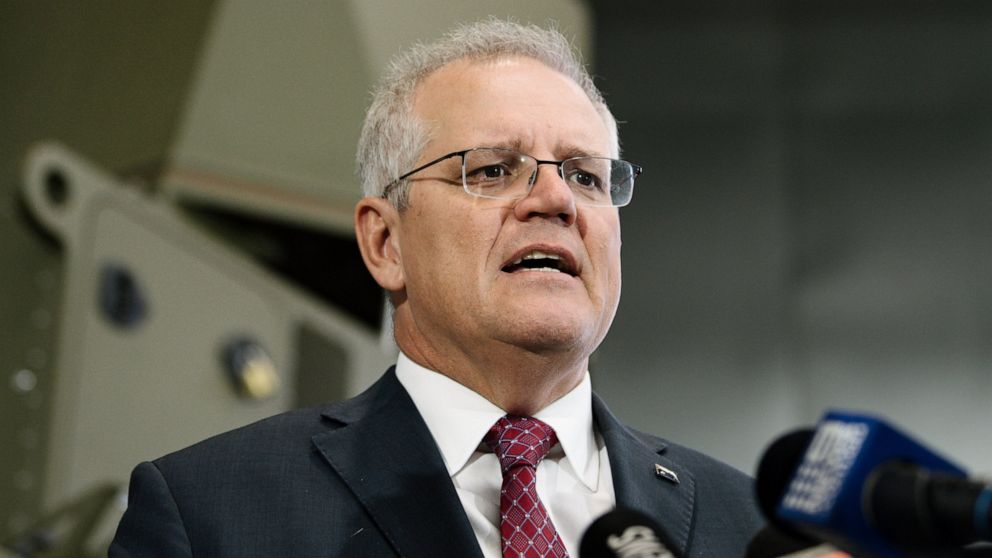
 The Associated Press
The Associated Press
Australian Prime Minister Scott Morrison speaks during the opening of Raytheon Australia's Centre for Joint Integration in Adelaide, Wednesday, March 31, 2021. Australia announced Wednesday it would begin building its own guided missiles in close collaboration with the U.S. as it seeks to boost its defense capabilities. Citing the "changing global environment,” Morrison said it would partner with a weapons manufacturer to build the missiles in a plan that would create thousands of jobs as well as export opportunities. (Morgan Sette/AAP Image via AP)
WELLINGTON, New Zealand -- Australia announced Wednesday it would begin building its own guided missiles in close collaboration with the U.S. as it seeks to boost its defense capabilities.
The news comes amid growing unease in the Pacific region about China's increasing assertiveness and military abilities.
Citing the "changing global environment,” Prime Minister Scott Morrison said it would partner with a weapons manufacturer to build the missiles in a plan that would create thousands of jobs as well as export opportunities.
Morrison said it would initially spend 1 billion Australian dollars ($761 million) on the plan as part of a huge 10-year investment in defense and the defense industry.
“Creating our own sovereign capability on Australian soil is essential to keep Australians safe,” Morrison said.
It has been decades since Australia last manufactured advanced missiles, and it currently relies on importing them from allies including the U.S. Australia does currently build a decoy rocket aimed at disrupting incoming missiles.
Michael Shoebridge, the director of defense, strategy and national security at the independent think tank Australian Strategic Policy Institute, said the announcement was welcome news and filled a strategic gap.
“It’s being driven by the two Cs, China and COVID,” Shoebridge said.
He said China's increasing aggression was a big concern for Australia, as was the vulnerability of global supply chains that had been exposed by the coronavirus pandemic.
He said Australia's most pressing need was for long-range anti-ship missiles that could be fired from warships or aircraft. He said that new army fighting vehicles also needed missile capabilities.
Shoebridge said it would make sense for Australia to build a new generation of hypersonic missiles in collaboration with the U.S. He said potential commercial partners included large U.S. weapons manufacturers like Lockheed Martin and Raytheon, although other manufacturers might be involved in developing specific systems, for instance propulsion.
Australia is part of the “Five Eyes” intelligence alliance, along with the U.S., Canada, Britain and New Zealand.
“We will work closely with the United States on this important initiative to ensure that we understand how our enterprise can best support both Australia’s needs and the growing needs of our most important military partner," Defense Minister Peter Dutton said.
He said building weapons in Australia would not only enhance its capabilities but would also ensure the nation had sufficient supply for combat operations if there was any disruption to global supply chains.
Before the announcement, the Australian Strategic Policy Institute had estimated that Australia would need to spend AU$100 billion over the next 20 years on buying missiles and guided weapons.
Shoebridge said the home-built missiles would help provide a military deterrent during the current decade while Australia waited for a series of new frigates and attack-class submarines to be built.
He said that in the event of a conflict, Australia would need a lot of missiles quickly and couldn't rely on importing them on time. He said such a scenario was possible, for instance if Beijing decided the time was right to take control of Taiwan by force.
He said the announcement also fitted with the U.S. strategy of dispersing its forces and capabilities so it wasn't vulnerable in any key locations.
Australia to build guided missiles to boost defense capacity - ABC News (go.com)
Australia says it will begin building its own guided missiles in close collaboration with the U.S. as it seeks to boost its defense capabilities
By NICK PERRY Associated Press
30 March 2021, 21:15

Australian Prime Minister Scott Morrison speaks during the opening of Raytheon Australia's Centre for Joint Integration in Adelaide, Wednesday, March 31, 2021. Australia announced Wednesday it would begin building its own guided missiles in close collaboration with the U.S. as it seeks to boost its defense capabilities. Citing the "changing global environment,” Morrison said it would partner with a weapons manufacturer to build the missiles in a plan that would create thousands of jobs as well as export opportunities. (Morgan Sette/AAP Image via AP)
WELLINGTON, New Zealand -- Australia announced Wednesday it would begin building its own guided missiles in close collaboration with the U.S. as it seeks to boost its defense capabilities.
The news comes amid growing unease in the Pacific region about China's increasing assertiveness and military abilities.
Citing the "changing global environment,” Prime Minister Scott Morrison said it would partner with a weapons manufacturer to build the missiles in a plan that would create thousands of jobs as well as export opportunities.
Morrison said it would initially spend 1 billion Australian dollars ($761 million) on the plan as part of a huge 10-year investment in defense and the defense industry.
“Creating our own sovereign capability on Australian soil is essential to keep Australians safe,” Morrison said.
It has been decades since Australia last manufactured advanced missiles, and it currently relies on importing them from allies including the U.S. Australia does currently build a decoy rocket aimed at disrupting incoming missiles.
Michael Shoebridge, the director of defense, strategy and national security at the independent think tank Australian Strategic Policy Institute, said the announcement was welcome news and filled a strategic gap.
“It’s being driven by the two Cs, China and COVID,” Shoebridge said.
He said China's increasing aggression was a big concern for Australia, as was the vulnerability of global supply chains that had been exposed by the coronavirus pandemic.
He said Australia's most pressing need was for long-range anti-ship missiles that could be fired from warships or aircraft. He said that new army fighting vehicles also needed missile capabilities.
Shoebridge said it would make sense for Australia to build a new generation of hypersonic missiles in collaboration with the U.S. He said potential commercial partners included large U.S. weapons manufacturers like Lockheed Martin and Raytheon, although other manufacturers might be involved in developing specific systems, for instance propulsion.
Australia is part of the “Five Eyes” intelligence alliance, along with the U.S., Canada, Britain and New Zealand.
“We will work closely with the United States on this important initiative to ensure that we understand how our enterprise can best support both Australia’s needs and the growing needs of our most important military partner," Defense Minister Peter Dutton said.
He said building weapons in Australia would not only enhance its capabilities but would also ensure the nation had sufficient supply for combat operations if there was any disruption to global supply chains.
Before the announcement, the Australian Strategic Policy Institute had estimated that Australia would need to spend AU$100 billion over the next 20 years on buying missiles and guided weapons.
Shoebridge said the home-built missiles would help provide a military deterrent during the current decade while Australia waited for a series of new frigates and attack-class submarines to be built.
He said that in the event of a conflict, Australia would need a lot of missiles quickly and couldn't rely on importing them on time. He said such a scenario was possible, for instance if Beijing decided the time was right to take control of Taiwan by force.
He said the announcement also fitted with the U.S. strategy of dispersing its forces and capabilities so it wasn't vulnerable in any key locations.
Australia to build guided missiles to boost defense capacity - ABC News (go.com)
northern watch
TB Fanatic
U.S. Ambassador Visits Taiwan for First Trip Since 1979
Trump lifted ban on travel to Taiwan in final days of his term
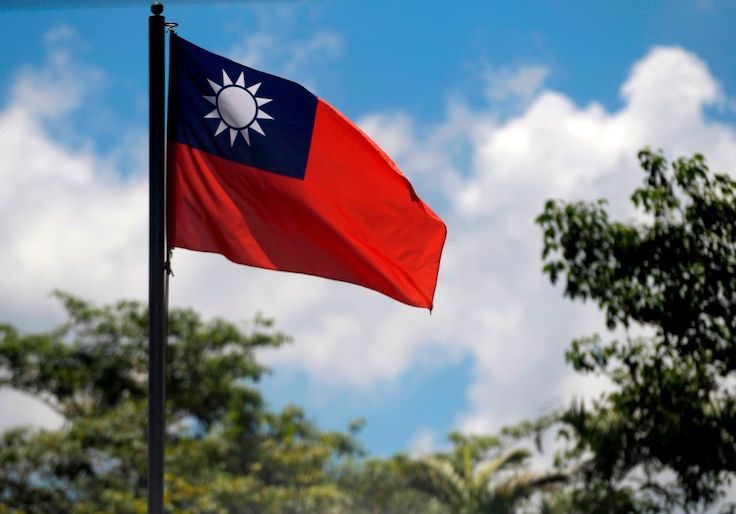
Getty Images
Jack Beyrer - MARCH 30, 2021 12:50 PM
Free Beacon
The Biden administration sent an ambassador on a diplomatic trip to Taiwan, an action made possible by changes to diplomatic rules made in the final days of the Trump administration.
On Monday, President Biden sent U.S. ambassador to Palau John Hennessey-Niland to Taiwan, marking the first visit to the island nation by an American ambassador since 1979. The visit comes months after a flurry of actions from the Trump administration that strengthened diplomatic relations between Taiwan and the United States.
In the final days of the administration, Secretary of State Mike Pompeo lifted several long-standing bans on official U.S. diplomatic engagement with the country. Pompeo planned to send former U.N. ambassador Kelly Craft to Taiwan in January as a capstone event to rebuilding ties with the country, but, after citing the Biden transition, he canceled all State Department travel.
Biden, however, appears prepared to pick up where the Trump administration left off. Though the president and some of his top advisers have a history of not supporting America’s commitments to Taiwan, the administration has leaned into protecting the nation as military threats from China grow.
The visit from Hennessey-Niland comes soon after House Republicans sent a letter to the Biden administration demanding increased support for Taiwan. Several senior military leaders also testified before Congress in March that China's first priority is to invade Taiwan, potentially "in the next six years," and the United States may not be able to defend the country.
Taiwan’s ability to defend itself could receive assistance from a muscular American defense budget. It is unclear, however, if the Biden administration will follow through on this effort. Several actions by congressional Democrats indicate that President Biden may cap the defense budget at flat levels, likely limiting America’s ability to defend Taiwan.
U.S. Ambassador Visits Taiwan for First Trip Since 1979 - Washington Free Beacon
Trump lifted ban on travel to Taiwan in final days of his term
Getty Images
Jack Beyrer - MARCH 30, 2021 12:50 PM
Free Beacon
The Biden administration sent an ambassador on a diplomatic trip to Taiwan, an action made possible by changes to diplomatic rules made in the final days of the Trump administration.
On Monday, President Biden sent U.S. ambassador to Palau John Hennessey-Niland to Taiwan, marking the first visit to the island nation by an American ambassador since 1979. The visit comes months after a flurry of actions from the Trump administration that strengthened diplomatic relations between Taiwan and the United States.
In the final days of the administration, Secretary of State Mike Pompeo lifted several long-standing bans on official U.S. diplomatic engagement with the country. Pompeo planned to send former U.N. ambassador Kelly Craft to Taiwan in January as a capstone event to rebuilding ties with the country, but, after citing the Biden transition, he canceled all State Department travel.
Biden, however, appears prepared to pick up where the Trump administration left off. Though the president and some of his top advisers have a history of not supporting America’s commitments to Taiwan, the administration has leaned into protecting the nation as military threats from China grow.
The visit from Hennessey-Niland comes soon after House Republicans sent a letter to the Biden administration demanding increased support for Taiwan. Several senior military leaders also testified before Congress in March that China's first priority is to invade Taiwan, potentially "in the next six years," and the United States may not be able to defend the country.
Taiwan’s ability to defend itself could receive assistance from a muscular American defense budget. It is unclear, however, if the Biden administration will follow through on this effort. Several actions by congressional Democrats indicate that President Biden may cap the defense budget at flat levels, likely limiting America’s ability to defend Taiwan.
U.S. Ambassador Visits Taiwan for First Trip Since 1979 - Washington Free Beacon
jward
passin' thru
Duan Dang
@duandang
1h
Canadian warship transits South China Sea as diplomatic tensions remain high
View: https://twitter.com/duandang/status/1377467880363548676?s=20
@duandang
1h
Canadian warship transits South China Sea as diplomatic tensions remain high
View: https://twitter.com/duandang/status/1377467880363548676?s=20
jward
passin' thru

EndGameWW3
@EndGameWW3
Chinese ship to Filipino aircraft in West PH Sea: 'Leave immediately, keep out'
View: https://twitter.com/EndGameWW3/status/1377437131958841347?s=20
Some body is asking for a couple of special delivery Mk82s.....
EndGameWW3
@EndGameWW3
Chinese ship to Filipino aircraft in West PH Sea: 'Leave immediately, keep out'
View: https://twitter.com/EndGameWW3/status/1377437131958841347?s=20
jward
passin' thru
Indo-Pacific News - Watching the CCP-China Threat
@IndoPac_Info
33m
#China’s New Super Submarine Dwarfs the #Russian Typhoon Class The new sub, the Type-100 Class, is armed with 48 Submarine Launched Ballistic Missiles (SLBMs) & nuclear torpedoes A hangar on its back indicates a smaller submarine will also be supported.
View: https://twitter.com/IndoPac_Info/status/1377499161059205122?s=20
@IndoPac_Info
33m
#China’s New Super Submarine Dwarfs the #Russian Typhoon Class The new sub, the Type-100 Class, is armed with 48 Submarine Launched Ballistic Missiles (SLBMs) & nuclear torpedoes A hangar on its back indicates a smaller submarine will also be supported.
View: https://twitter.com/IndoPac_Info/status/1377499161059205122?s=20
Last edited:
jward
passin' thru

Indo-Pacific News - Watching the CCP-China Threat
@IndoPac_Info
11m
#Japan signs deal to export defense equipment to #Indonesia Japan & Indonesia signed on Tuesday a deal enabling exports of Japanese defense equipment to Indonesia, as they try to boost cooperation amid #China's rising assertiveness in regional waters.
View: https://twitter.com/IndoPac_Info/status/1377563350867927042?s=20
northern watch
TB Fanatic
northern watch
TB Fanatic
jward
passin' thru
Indo-Pacific News - Watching the CCP-China Threat
@IndoPac_Info
2h
#Indonesia, #Japan on verge of record gunboat deal Jakarta poised to purchase eight Mogami-class frigates to bolster its naval defenses amid rising #Chinese incursions Japan to deliver four of the 3,900-ton frigates, beginning in late 2023 or early 2024
View: https://twitter.com/IndoPac_Info/status/1377798871284215811?s=20
2) Government sources say the provisional plan calls for Japan to deliver four of the 3,900-ton frigates, beginning in late 2023 or early 2024, and for the remaining four to be built at state-run PT PAL’s Surabaya shipyard.
View: https://twitter.com/IndoPac_Info/status/1377798876543950856?s=20
3) The first of the stealthy Mogami-class frigates, with a sticker price of US$450 million, is currently being built by Mitsubishi Heavy Industries and Mitsui Engineering and Shipbuilding for the Japanese Maritime Self-Defense Force at shipyards in Nagasaki and Tamano.
View: https://twitter.com/IndoPac_Info/status/1377798881287675906?s=20
@IndoPac_Info
2h
#Indonesia, #Japan on verge of record gunboat deal Jakarta poised to purchase eight Mogami-class frigates to bolster its naval defenses amid rising #Chinese incursions Japan to deliver four of the 3,900-ton frigates, beginning in late 2023 or early 2024
View: https://twitter.com/IndoPac_Info/status/1377798871284215811?s=20
2) Government sources say the provisional plan calls for Japan to deliver four of the 3,900-ton frigates, beginning in late 2023 or early 2024, and for the remaining four to be built at state-run PT PAL’s Surabaya shipyard.
View: https://twitter.com/IndoPac_Info/status/1377798876543950856?s=20
3) The first of the stealthy Mogami-class frigates, with a sticker price of US$450 million, is currently being built by Mitsubishi Heavy Industries and Mitsui Engineering and Shipbuilding for the Japanese Maritime Self-Defense Force at shipyards in Nagasaki and Tamano.
View: https://twitter.com/IndoPac_Info/status/1377798881287675906?s=20
jward
passin' thru
Indo-Pacific News - Watching the CCP-China Threat
@IndoPac_Info
20,000 #Chinese residents on #Senkakus? #Japan rushes to buoy defense #China is planning to reclaim land around the Senkakus and move around 20,000 people there according to an expert. Japan's lack of resolve only encouraged more Chinese incursions.
2) Amid repeated Chinese incursions in waters near the Senkakus, such scenarios are not out of the question any more. Discussions within Japan's ruling party have reignited regarding the need for legislation that explicitly lays out the rules of engagement in such cases.
View: https://twitter.com/IndoPac_Info/status/1377809934801235968?s=20
@IndoPac_Info
20,000 #Chinese residents on #Senkakus? #Japan rushes to buoy defense #China is planning to reclaim land around the Senkakus and move around 20,000 people there according to an expert. Japan's lack of resolve only encouraged more Chinese incursions.
2) Amid repeated Chinese incursions in waters near the Senkakus, such scenarios are not out of the question any more. Discussions within Japan's ruling party have reignited regarding the need for legislation that explicitly lays out the rules of engagement in such cases.
View: https://twitter.com/IndoPac_Info/status/1377809934801235968?s=20
jward
passin' thru

Steve Lookner
@lookner
36 dead in Taiwan train derailment
View: https://twitter.com/lookner/status/1377838333540364291?s=20
northern watch
TB Fanatic
jward
passin' thru
Indo-Pacific News - Watching the CCP-China Threat
@IndoPac_Info
3m
#France to lead #Quad naval drill in #IndoPacific challenge to #China In a first, #India will join its Quad partners -- #Australia, #Japan and the #US -- in a French-led naval drill called "La Perouse exercise" in the Bay of Bengal next week.
View: https://twitter.com/IndoPac_Info/status/1378209965333090304?s=20
@IndoPac_Info
3m
#France to lead #Quad naval drill in #IndoPacific challenge to #China In a first, #India will join its Quad partners -- #Australia, #Japan and the #US -- in a French-led naval drill called "La Perouse exercise" in the Bay of Bengal next week.
View: https://twitter.com/IndoPac_Info/status/1378209965333090304?s=20
jward
passin' thru

EHA News
@eha_news
2 Chinese ships enter Japanese territorial waters in East China Sea
Two Chinese-flagged coast guard ships reportedly entered Japanese territorial waters yesterday around disputed Senkaku Islands in the East China Sea.
Japan Coast Guard warned Chinese ships to leave the area.
View: https://twitter.com/eha_news/status/1378223780552708097?s=20
jward
passin' thru
Collin Koh
@CollinSLKoh
Taiwan's Coast Guard Administration notes recent PRC drone reconnaissance sorties in the airspace of Pratas Islands. As precaution against potential PRC military aggression, defenses on Pratas Islands and Itu Aba in the Spratlys would be beefed up. https://cna.com.tw/news/firstnews
@CollinSLKoh
Taiwan's Coast Guard Administration notes recent PRC drone reconnaissance sorties in the airspace of Pratas Islands. As precaution against potential PRC military aggression, defenses on Pratas Islands and Itu Aba in the Spratlys would be beefed up. https://cna.com.tw/news/firstnews
jward
passin' thru

War on the Rocks
@WarOnTheRocks
1h
Chinese analysts and government entities are increasingly calling for some form of Indian Ocean force that can protect and project China's interests
View: https://twitter.com/WarOnTheRocks/status/1378459812070109188?s=20

War on the Rocks
@WarOnTheRocks
1h
Chinese analysts and government entities are increasingly calling for some form of Indian Ocean force that can protect and project China's interests
View: https://twitter.com/WarOnTheRocks/status/1378459812070109188?s=20
That implies them having bases in the area of operations. I guess the Pakistanis are going to get more "tenants" at Gwadar and or there are going to be a lot of "port visits" to Bandar Abbas and Chahbaher......
northern watch
TB Fanatic
I would not be surprised to see a "formal" Chinese navy base established in PakistanThat implies them having bases in the area of operations. I guess the Pakistanis are going to get more "tenants" at Gwadar and or there are going to be a lot of "port visits" to Bandar Abbas and Chahbaher......
jward
passin' thru

H I Sutton
@CovertShores
6m
BREAKING: North Korea has built another new Surface Effect Ship (SES). http://hisutton.com/North-Korea-Builds-Surface-Effect-Warship.html
Not seen any reports on this, likely only rolled out of the shed in past few days. Spotted in low-res imagery, confirmed and identified in Airbus high-res.
View: https://twitter.com/CovertShores/status/1378610097484619778?s=20
jward
passin' thru
FXHedge
@Fxhedgers
3h
JAPAN SCRAMBLES FIGHTER JETS AFTER FIVE CHINESE NAVY VESSELS PASS THROUGH THE MIYAKO STRAIT NEAR OKINAWA -NIKKEI
____________________________________
https://twitter.com/Fxhedgers/status/1378899922901082115
JAPAN'S KATO: WATCHING MOVEMENT OF CHINESE CARRIER NEAR OKINAWA
@Fxhedgers
3h
JAPAN SCRAMBLES FIGHTER JETS AFTER FIVE CHINESE NAVY VESSELS PASS THROUGH THE MIYAKO STRAIT NEAR OKINAWA -NIKKEI
____________________________________
https://twitter.com/Fxhedgers/status/1378899922901082115
JAPAN'S KATO: WATCHING MOVEMENT OF CHINESE CARRIER NEAR OKINAWA
FXHedge
@Fxhedgers
3h
JAPAN SCRAMBLES FIGHTER JETS AFTER FIVE CHINESE NAVY VESSELS PASS THROUGH THE MIYAKO STRAIT NEAR OKINAWA -NIKKEI
____________________________________
View: https://twitter.com/Fxhedgers/status/1378899922901082115
JAPAN'S KATO: WATCHING MOVEMENT OF CHINESE CARRIER NEAR OKINAWA
Posted for fair use.....
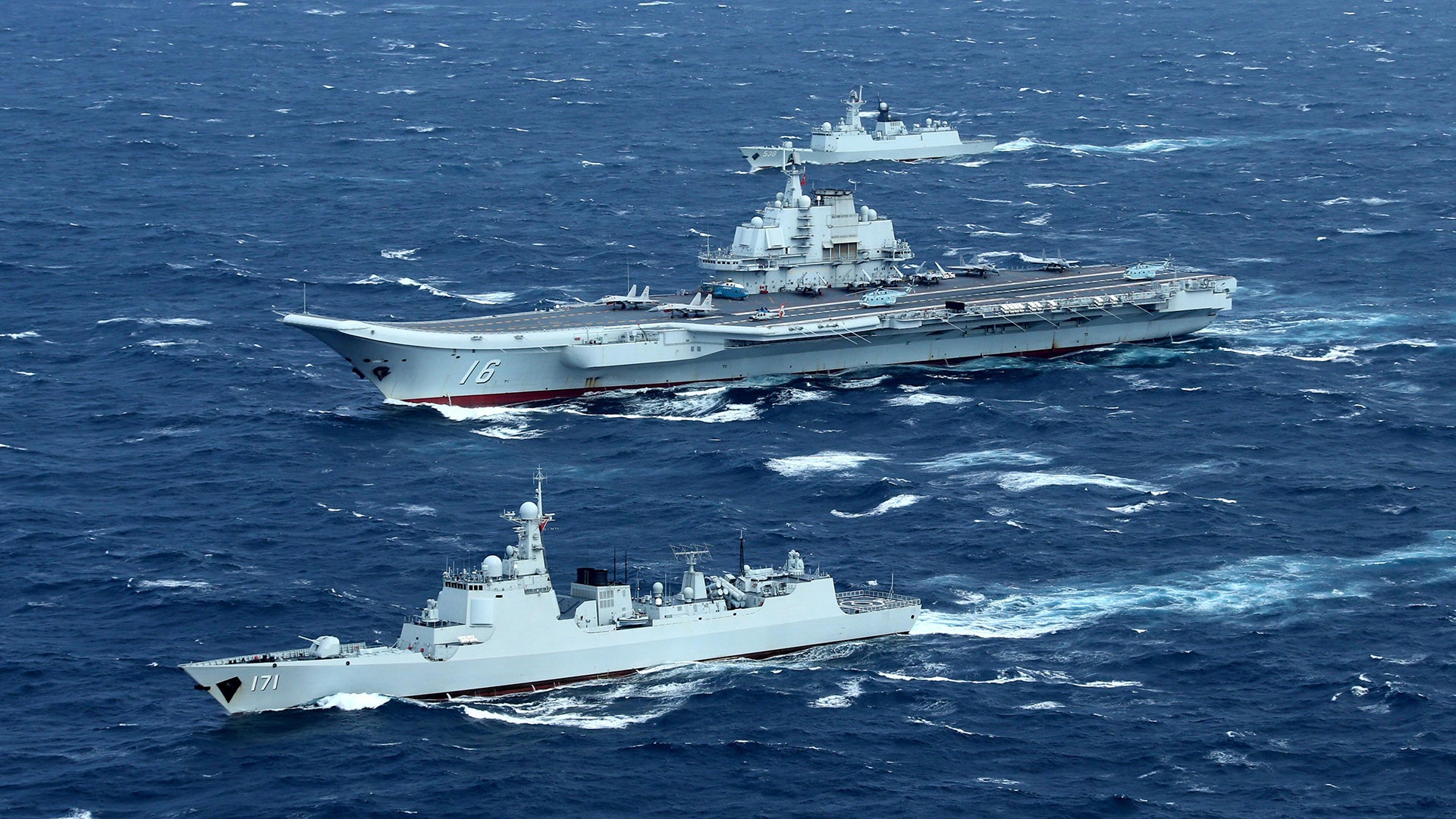
China's Liaoning Carrier Strike Group Passes Through Japan’s Miyako Strait
China's ability to integrate its carriers with an increasingly advanced strike group continues to evolve, as does its blue water operations ambitions.
China's Liaoning Carrier Strike Group Passes Through Japan’s Miyako Strait
China's ability to integrate its carriers with an increasingly advanced strike group continues to evolve, as does its blue water operations ambitions.
BY ADAM KEHOE APRIL 4, 2021
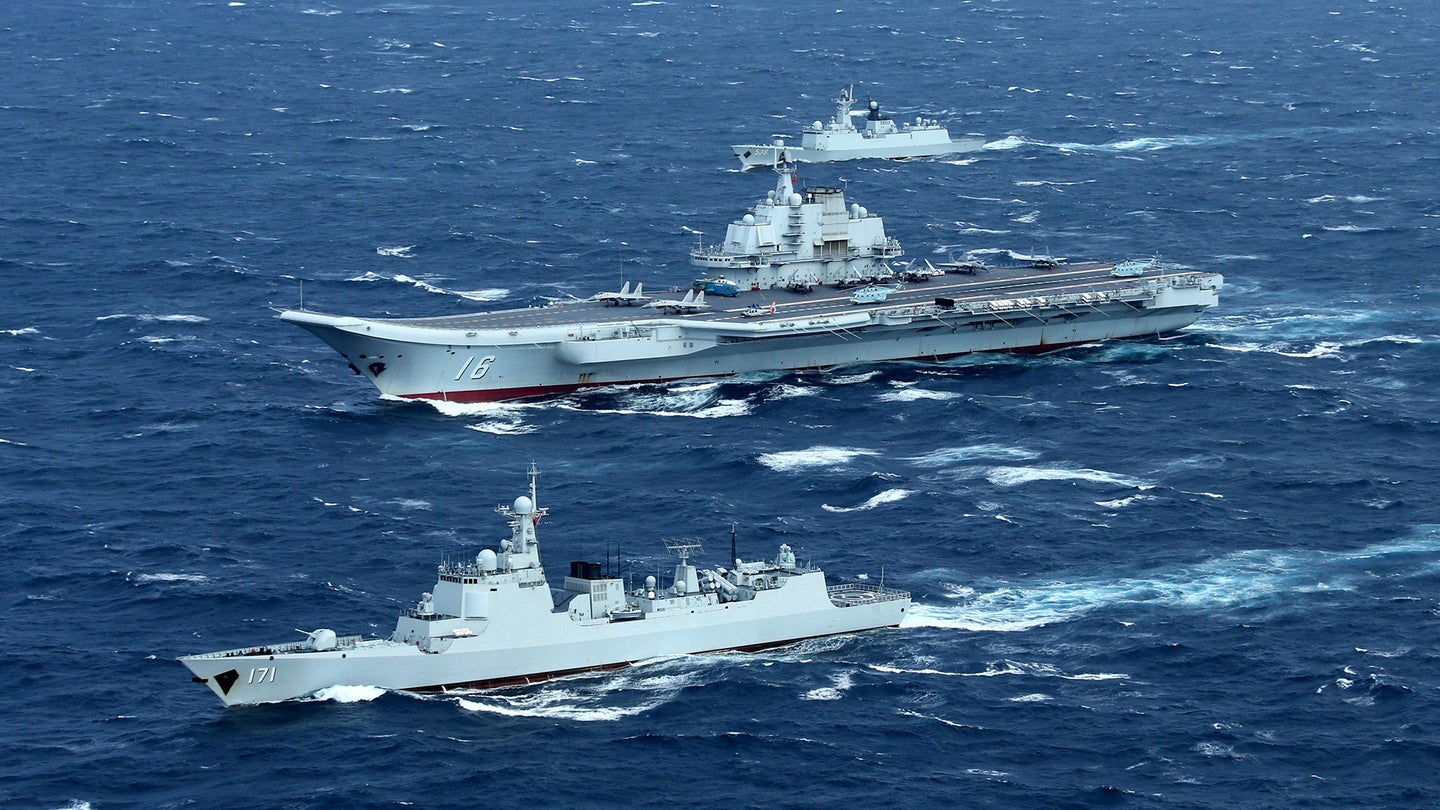
SHARE
China’s first aircraft carrier, the Liaoning, passed through the Miyako Strait, just southwest of Okinawa, on Sunday. The reworked Russian-built carrier appeared to be traveling with a retinue of five ships that make up its strike group.
According to a report from the Japan Self Defense Forces, the group included:
- 2 Type 052D Luyang class destroyers
- 1 Type 055 Renhai class missile destroyer
- 1 Type 054A Jiangkai class II frigate
- 1 Type 901 Fuyu class fast combat support ship
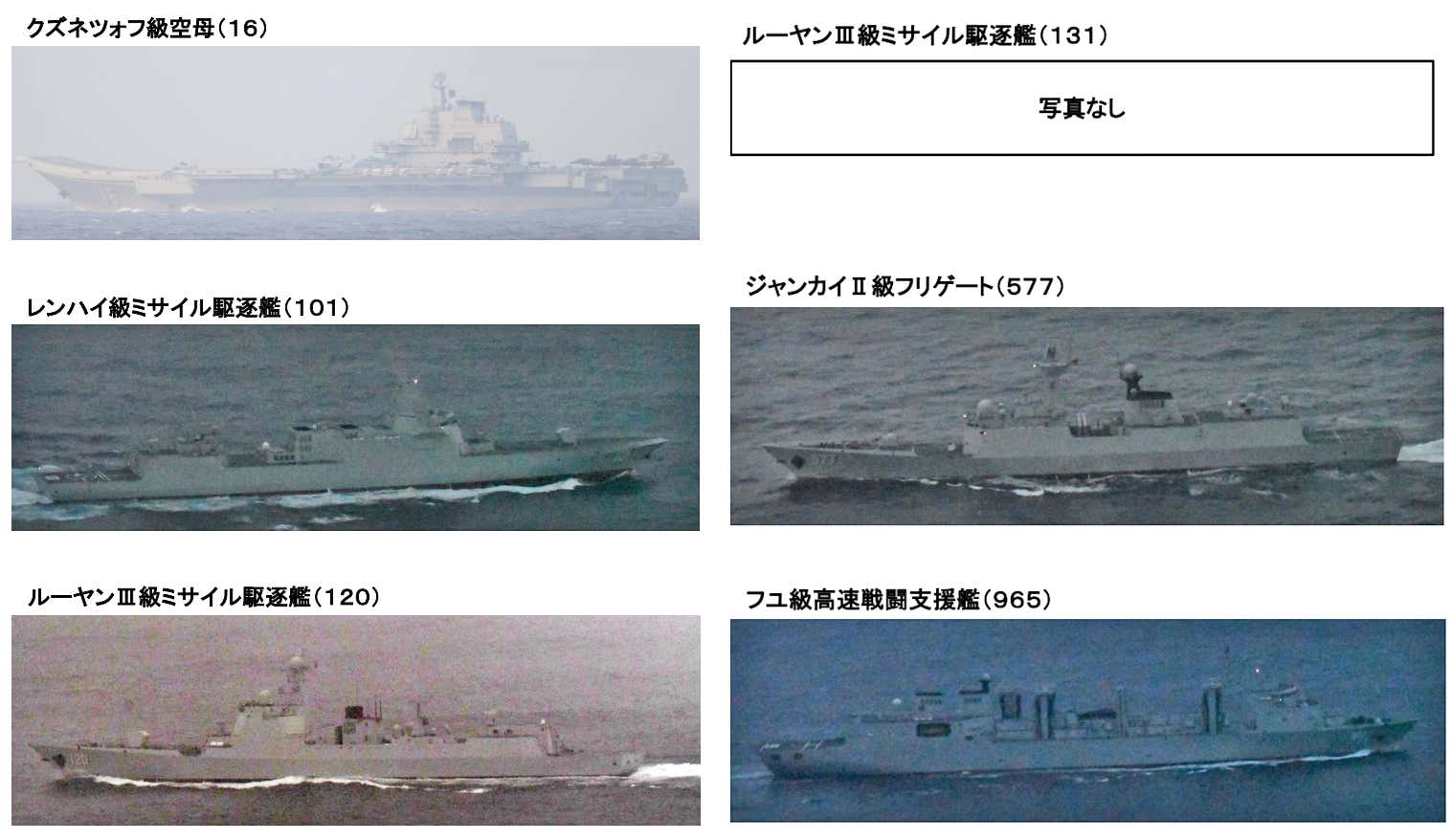
JAPAN SELF DEFENSE FORCES
Imagery of the Liaoning's carrier strike group that moved through Miyako Strait.
Additionally, the JSDF detected a Shaanxi Y-9 flying over the Miyako Strait, and ultimately scrambled to intercept it. China has uniquely configured Y-9s for a number of roles. Usually, they are of the electronic surveillance or maritime patrol type when they are involved in an incident like this. That way, the aircraft can monitor the response to the vessels' presence and garner valuable intelligence on a nation's readiness and sources and methods used to track the flotilla.
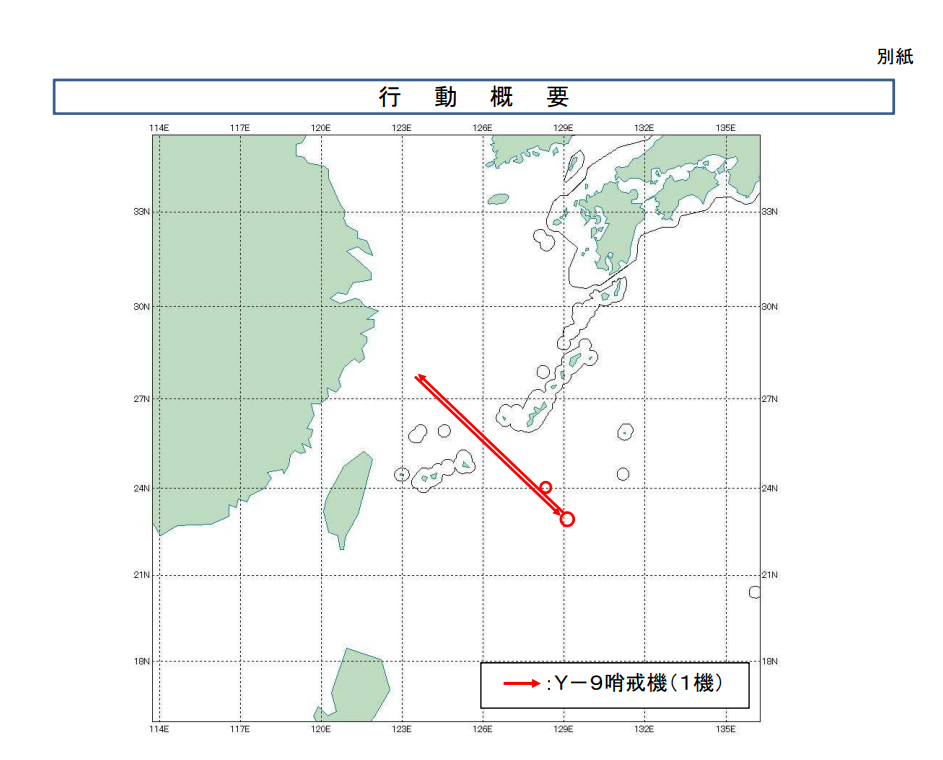
JSDF
The track of the Y-9.
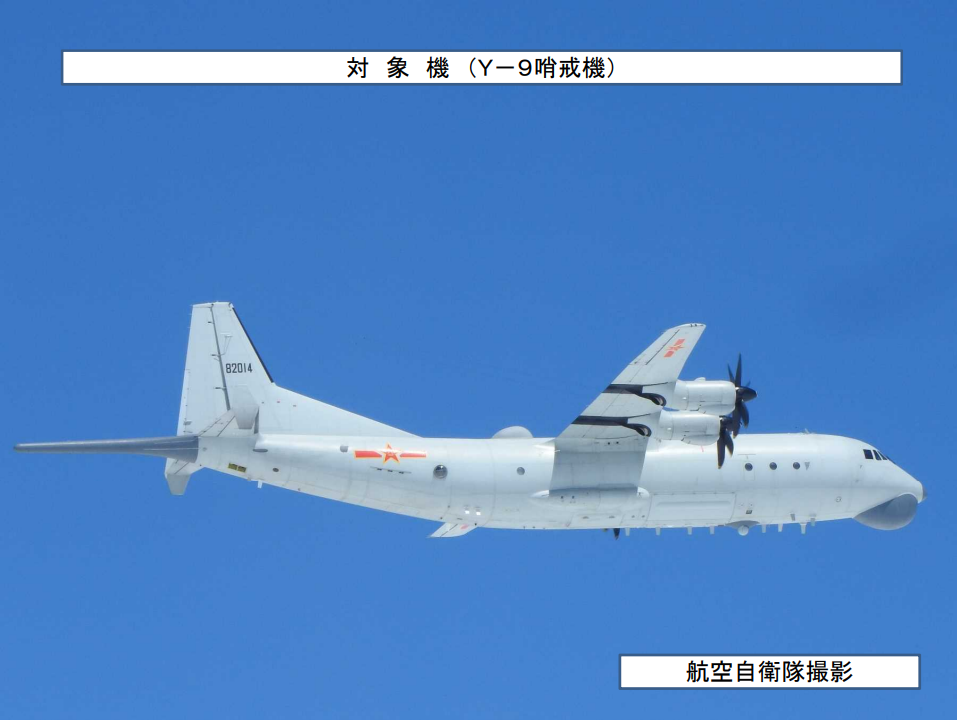
JSDF
In recent years, Japan has routinely scrambled aircraft to intercept territorial incursions, largely in reaction to Chinese overflights. According to the Japanese Ministry of Defense, there have been thousands of such scrambles in recent years.
While the Miyako Strait provides a narrow passage of international waters through Japan’s exclusive economic zone, it is widely seen as a highly strategic waterway. Speaking to The Diplomat, a specialist in Chinese security affairs for the United States Air Force, Ben Lowsen, said, “Chinese strategists see these passages as crucial to their ability to deploy forces beyond the first island chain.”
The Liaoning’s movements, while legal under international law, demonstrate Beijing’s increasingly assertive posture and their growing familiarity with integrated carrier strike group operations in the open ocean.
In addition to the Y-9 intercept, during the same period of time, Taiwan reported aircraft incursions in their airspace. Taiwan’s Ministry of Defense reported an overflight from a PLA Shaanxi Y-8 transport over the Taiwan Strait:
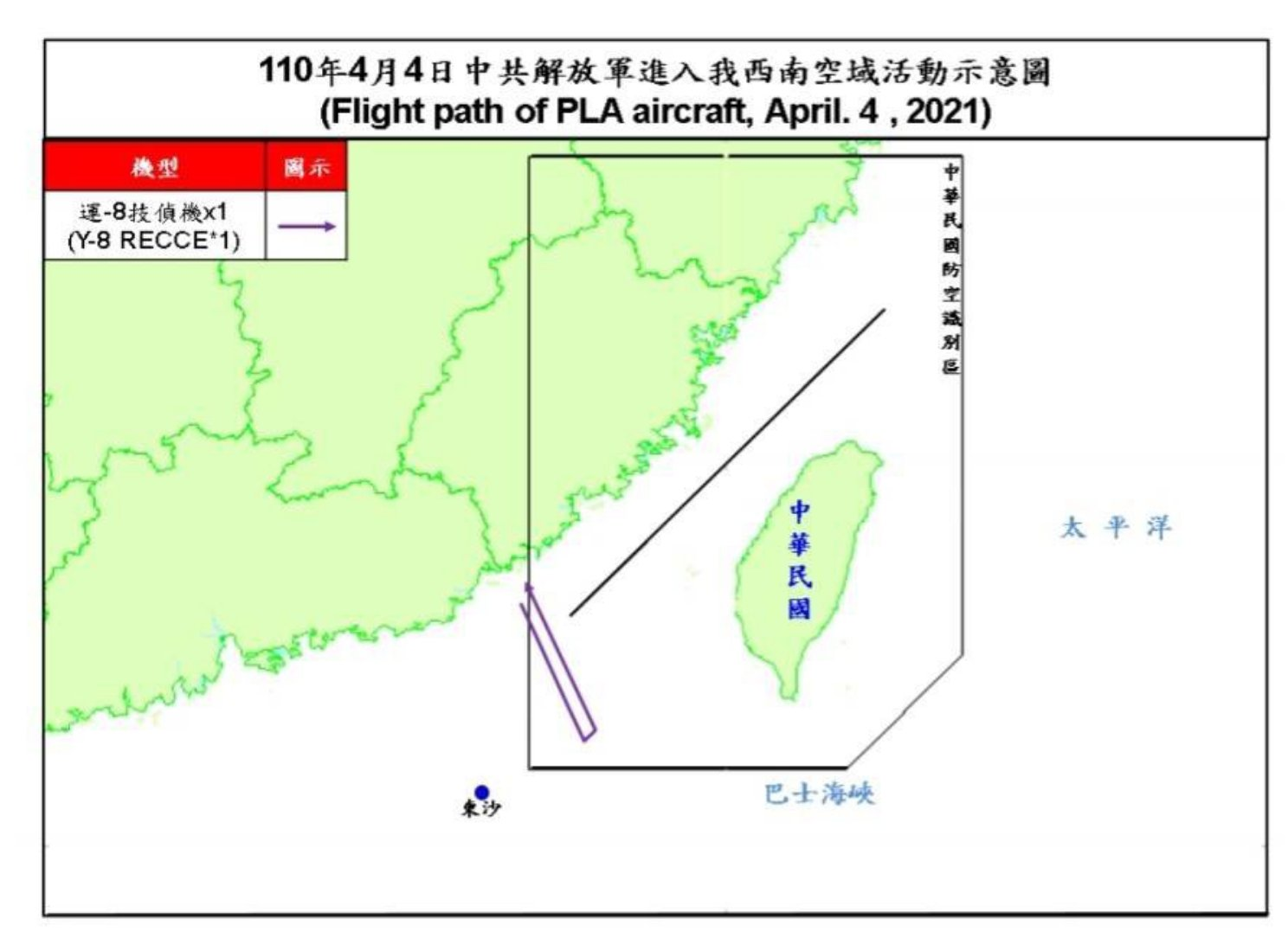
TAIWAN MOD
Track of a Chinese Y-8 transport around the same time as the carrier group's transit through the strait.
Provocative ship movements are also nothing new in the region. The Liaoning previously crossed the Miyako Strait with its strike group in April 2020, creating international headlines. At the time, China boasted the only operational aircraft carrier in the region after the USS Theodore Roosevelt and USS Ronald Reagan were forced pier-side due to COVID-19. The Chinese carrier's first transit through the strait occurred five years ago, in 2016.
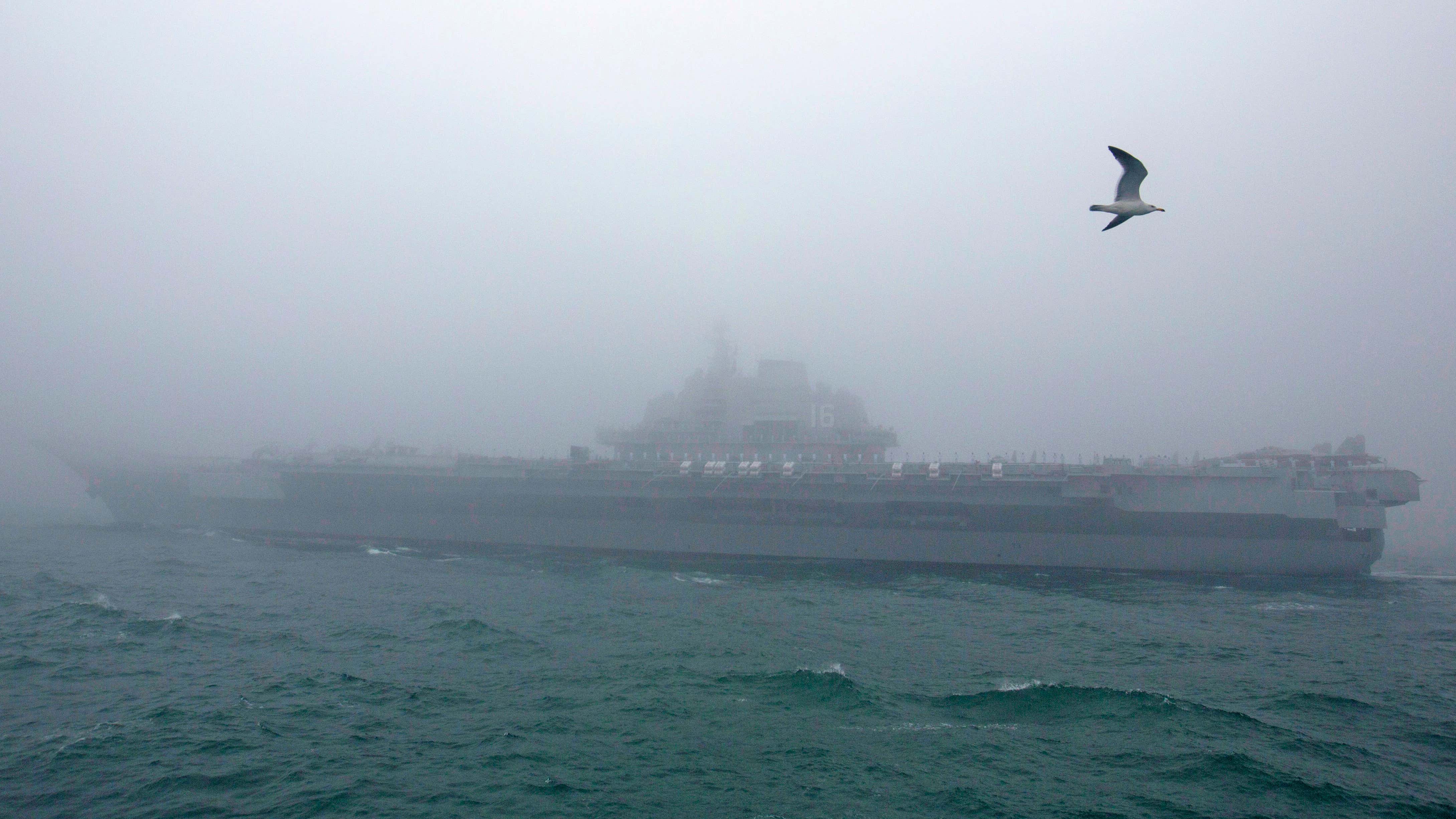
AP
The carrier’s move also comes at a tense time in other contested areas that China is asserting its growing might over, namely in the South China Sea. On March 22 the Philippines demanded that China remove more than two hundred vessels spotted near a disputed reef. A recent expose by Foreign Policy demonstrated that dozens of the vessels are part of the People’s Armed Forces Maritime Militia (PAFMM), following a categorical denial from Chinese officials.
While this most recent incident in the South China Sea is another in a long line of aggressive acts orchestrated by the Chinese in the littorals, Liaoning moving out beyond the first island chain with a mature strike group is a reminder of the People’s Liberation Army Navy’s blue-water ambitions. These are only set to grow as the country's naval capabilities and overall capacity to project power afar continue to improve.
With Liaoning and its indigenously-build clone, Shandong, now operating with their carrier strike groups on a regular basis, as well as China's third carrier—the Type 003—deep under construction in Shanghai, and more advanced carriers in development, Beijing's commitment to the power-projection capabilities of the aircraft carrier is crystal clear.
Contact the editor: Tyler@thedrive.com
danielboon
TB Fanatic
Tick tick tick...


